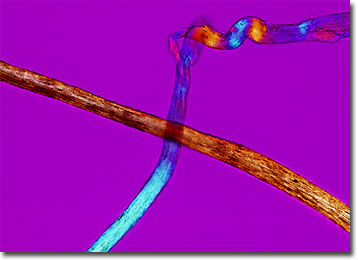Polarized Light Microscopy Digital Image Gallery
Scoured Sheep Wool
Humans first utilized the hides of wild sheep to make warm garments as many as 12,000 years ago. Since that time, the creation of clothing from the wool of sheep has increased greatly in complexity, but has correspondingly resulted in much finer forms of attire than those donned by people living in earlier periods of time.

The first step in the manufacture of woolen items is the shearing of wool from sheep, a practice that often varies in the way it is carried out. In some countries, for instance, all wool from a single sheep is shorn at once, while in other areas different grades of wool are removed separately. The latter methodology makes the following step, the grading and sorting of the wool, a simpler, more expedient process. After sorting, sheep wool undergoes scouring, a washing process that removes grease, perspiration, and debris from the fibers. When dried, the scoured wool is usually carded and combed before the processes of roving and spinning are begun. Once yarn has been spun from the wool, it is ready for knitting or weaving, but the cloth it is used to produce may also be subjected to a number of procedures in order to generate specific characteristics, such as waterproofing and shrink resistance.
Domesticated for as many as 7,000 years, sheep are gentle creatures that are raised around the world for their wool, as well as for their meat and milk. Countries that have large areas of grasslands available for grazing, such as the United States, Australia, China, and India, are the leading producers of sheep products. In order to increase quality and output of sheep utilized for various purposes, a number of breeds of the ruminants have been developed over the years. One of the most well known of these breeds is the Merino sheep, an animal that has been selectively bred over many centuries to produce unusually soft and lustrous wool rich in lanoline.
